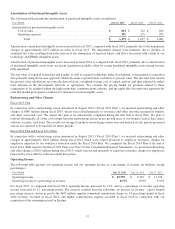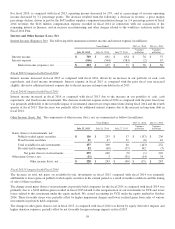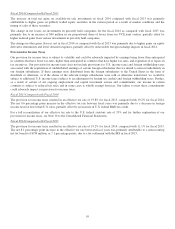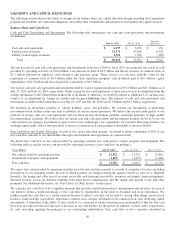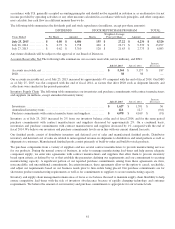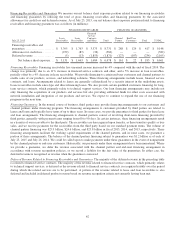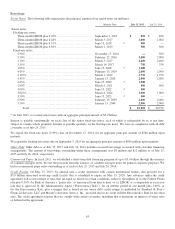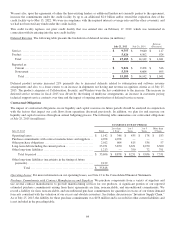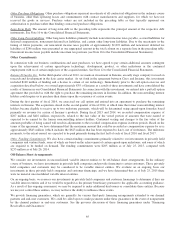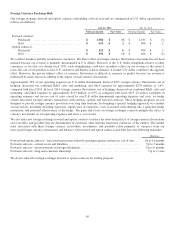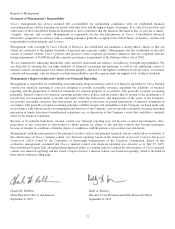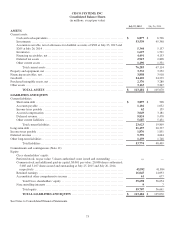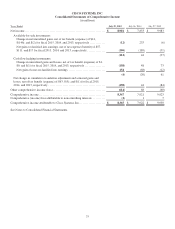Cisco 2015 Annual Report Download - page 73
Download and view the complete annual report
Please find page 73 of the 2015 Cisco annual report below. You can navigate through the pages in the report by either clicking on the pages listed below, or by using the keyword search tool below to find specific information within the annual report.
Other Purchase Obligations Other purchase obligations represent an estimate of all contractual obligations in the ordinary course
of business, other than operating leases and commitments with contract manufacturers and suppliers, for which we have not
received the goods or services. Purchase orders are not included in the preceding table as they typically represent our
authorization to purchase rather than binding contractual purchase obligations.
Long-Term Debt The amount of long-term debt in the preceding table represents the principal amount of the respective debt
instruments. See Note 10 to the Consolidated Financial Statements.
Other Long-Term Liabilities Other long-term liabilities primarily include noncurrent income taxes payable, accrued liabilities for
deferred compensation, noncurrent deferred tax liabilities, and certain other long-term liabilities. Due to the uncertainty in the
timing of future payments, our noncurrent income taxes payable of approximately $1,876 million and noncurrent deferred tax
liabilities of $246 million were presented as one aggregated amount in the total column on a separate line in the preceding table.
Noncurrent income taxes payable include uncertain tax positions (see Note 16 to the Consolidated Financial Statements).
Other Commitments
In connection with our business combinations and asset purchases, we have agreed to pay certain additional amounts contingent
upon the achievement of certain agreed-upon technology, development, product, or other milestones or the continued
employment with us of certain employees of the acquired entities. See Note 12 to the Consolidated Financial Statements.
Insieme Networks, Inc. In the third quarter of fiscal 2012, we made an investment in Insieme, an early stage company focused on
research and development in the data center market. As set forth in the agreement between Cisco and Insieme, this investment
included $100 million of funding and a license to certain of our technology. Immediately prior to the call option exercise and
acquisition described below, we owned approximately 83% of Insieme as a result of these investments and have consolidated the
results of Insieme in our Consolidated Financial Statements. In connection with this investment, we entered into a put/call option
agreement that provided us with the right to purchase the remaining interests in Insieme. In addition, the noncontrolling interest
holders could require us to purchase their shares upon the occurrence of certain events.
During the first quarter of fiscal 2014, we exercised our call option and entered into an agreement to purchase the remaining
interests in Insieme. The acquisition closed in the second quarter of fiscal 2014, at which time the former noncontrolling interest
holders became eligible to receive up to two milestone payments, which will be determined using agreed-upon formulas based
primarily on revenue for certain of Insieme’s products. During fiscal 2015 and 2014, we recorded compensation expense of
$207 million and $416 million, respectively, related to the fair value of the vested portion of amounts that were earned or
expected to be earned by the former noncontrolling interest holders. Continued vesting and changes to the fair value of the
amounts probable of being earned will result in adjustments to the recorded compensation expense in future periods. Based on the
terms of the agreement, we have determined that the maximum amount that could be recorded as compensation expense by us is
approximately $843 million (which includes the $623 million that has been expensed to date), net of forfeitures. The milestone
payments, to the extent earned, are expected to be paid primarily during the first half of each of fiscal 2016 and fiscal 2017.
Other Funding Commitments We also have certain funding commitments primarily related to our investments in privately held
companies and venture funds, some of which are based on the achievement of certain agreed-upon milestones, and some of which
are required to be funded on demand. The funding commitments were $205 million as of July 25, 2015, compared with
$255 million as of July 26, 2014.
Off-Balance Sheet Arrangements
We consider our investments in unconsolidated variable interest entities to be off-balance sheet arrangements. In the ordinary
course of business, we have investments in privately held companies and provide financing to certain customers. These privately
held companies and customers may be considered to be variable interest entities. We evaluate on an ongoing basis our
investments in these privately held companies and customer financings, and we have determined that as of July 25, 2015 there
were no material unconsolidated variable interest entities.
On an ongoing basis, we reassess our investments in privately held companies and customer financings to determine if they are
variable interest entities and if we would be regarded as the primary beneficiary pursuant to the applicable accounting guidance.
As a result of this ongoing assessment, we may be required to make additional disclosures or consolidate these entities. Because
we may not control these entities, we may not have the ability to influence these events.
We provide financing guarantees, which are generally for various third-party financing arrangements extended to our channel
partners and end-user customers. We could be called upon to make payments under these guarantees in the event of nonpayment
by the channel partners or end-user customers. See the previous discussion of these financing guarantees under “Financing
Receivables and Guarantees.”
65




